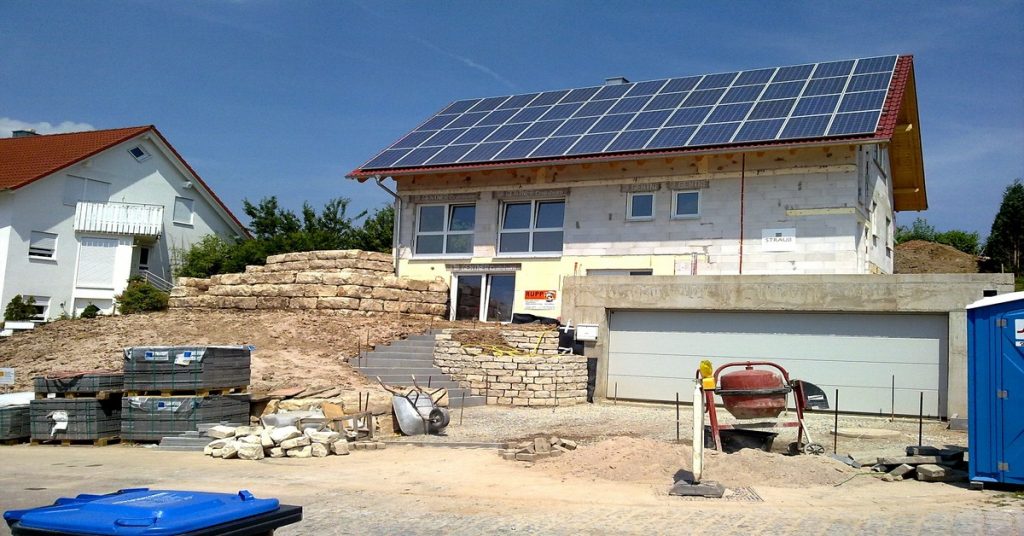

Passive houses are exactly what the name suggests—they don’t require any active use of energy or machinery. It might seem like all buildings are passive. However, the majority of houses run heating and air conditioning almost constantly. Yet, with a passive house design, you need to ventilate the building mechanically.
We’ll take you through the ins and outs of mechanical ventilation and how to implement this design yourself.
What is Mechanical Ventilation With Heat Recovery?
There are two main elements to MVHR: mechanical ventilation and heat recovery. Mechanical ventilation is a natural system to bring fresh air into the building. With a simple duct into the building, there is a continuous supply of fresh air. The unit removes stale air using either a low-energy fan (mechanical ventilation) or a heat exchanger (natural ventilation).
As mechanical ventilation by itself results in too much heat (and energy) loss, passive houses need a heat recovery system in place. Heat recovery uses a heat exchanger that extracts the heat from the warm air—the stale inside air—and transfers it to the cold, fresh outside air. Even in warmer climates, the outside air temperature is cooler.
The cool, fresh air is warmed up to a comfortable temperature with a heat exchanger as it extracts old air. The two airstreams don’t come into contact, ensuring the house is continuously supplied with clean air.

Why Do Passive Houses Need MVHR?
Passive houses that use mechanical ventilation and heat recovery systems offer comfort, energy efficiency, and controlled ventilation.
Comfort
Many Australians invest between $286 to $586 on the air conditioning a year. Heating and cooling take up 40% of the average household’s energy usage. Imagine living in a house that controls the air temperature for you.
With a pleasant temperature all year long, passive houses are perfectly comfortable. Moreover, mechanical ventilation in a passive home provides just the right amount of fresh air. Too much outside air would dry out the indoor air and aggravate respiratory problems. However, too little outside air encourages pollutants.
A mechanical ventilation heat recovery system removes odours, pollutants, stale air, and excess moisture.
Energy Efficiency
Passive houses are energy efficient. With global concerns centring on the climate crisis and rocketing energy bills, energy efficiency is at the forefront of many Australian minds. So, how energy efficient is mechanical ventilation? The International Passivhaus Standard requires MVHR units to be 75% or more efficient than alternative ventilation options.
However, it’s important to note that its energy efficiency is in relation to its comfort levels. To achieve the level of control and comfort over ventilation, an MVHR might use some energy. Yet, for a non-passive house, the energy levels used would be far higher to achieve the same stasis.
Controlled Ventilation
Naturally ventilated houses allow little control over fresh air flow as it relies on air pressure, wind, and stack effect. Actively ventilated houses enable control—but at the cost of high energy levels. However, a mechanically ventilated building offers the perfect balance of control, comfort, and low-energy use.
With an airtight building, the inhabitant can control precisely how much fresh air comes into the building. Plus, the heat exchange system ensures that the transference between stale and fresh air is always balanced.
Don’t think you cannot open a window. Just because the house is airtight, it doesn’t mean you’re sealed inside. Opening a window is part of the control—it’s your choice to allow more fresh air into the property.
However, air entering through windows and doors will cool the inside temperatures. But, because of the quality insulation and lack of thermal bridges, the internal temperatures will remain comfortable.
What Does Mechanical Ventilation Not Do?
What are the limitations of a mechanical ventilation unit?
- Provide air conditioning, cooling, or heating
- Recirculate stale air
- Without a heat recovery system, it loses heat
- Make indoor air unhealthy—the cool outside air is filtered
- Dry inside air or allow too much moisture
- Extract air from kitchen cookers—you still need a recirculation hood
Avoid situating your mechanical ventilation heat recovery unit too near cooking appliances. You want it to extract cooking odours without being close enough to get clogged up with grease.

How to Mechanically Ventilate a Passive House
One way of mechanically ventilating your house is to install a dry-fixed roof. Essentially, a dry-fixed roof uses mechanical fastenings to fix the roof tiles rather than traditional mortar. The benefit of dry fixing is that it allows a natural cooling passive system across the roof. This reduces heat transfer through the roof and ceiling without using a fan.
As the hot air rises out of the top of the roof, it pulls the cool, fresh air through the ventilation under the eaves. The continuous circulation of colder, outside air can save Australians up to 5% on their energy bills a year.
To install mechanical ventilation on your roof, follow our steps:
- Install the sarking and battens as usual across the roof
- Fix eaves vents around the perimeter of the roof
- Fix the batten holder with a gap between it and the roof tiles
- Lay the tiles and roll out the ridge flashing
To ensure maximum optimisation of your MVHR system, make your property airtight. Without drafts and air leaking, mechanical ventilation can properly control temperature levels within your home.
Bottom Line
Mechanically ventilating a passive house reduces your energy bills and maximises your comfort levels. It’s relatively easy and affordable to install. Additionally, passive house inhabitants will save significant money in heating or cooling their buildings. Why bother with an air conditioning system when your house ensures the perfect temperature for you?
Moreover, reduce your exposure to mould, dampness, and other pollutants. Your property will always be full of clean, fresh air with a mechanical ventilation unit.
